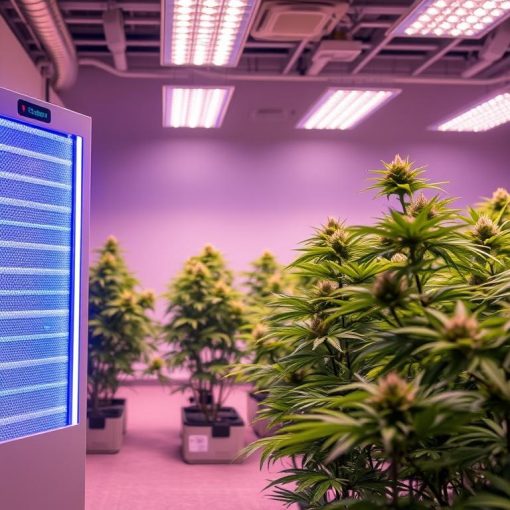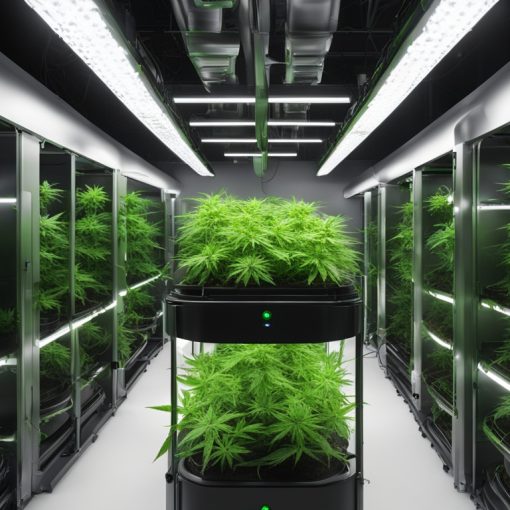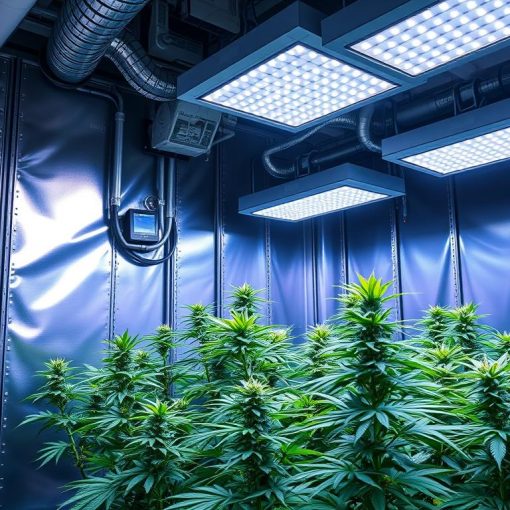In the world of cannabis cultivation, knowing how to manage vapor pressure deficit (VPD) is key. VPD affects the health and growth of your cannabis plants. By learning about VPD and how to control it, you can make your grow operation better.
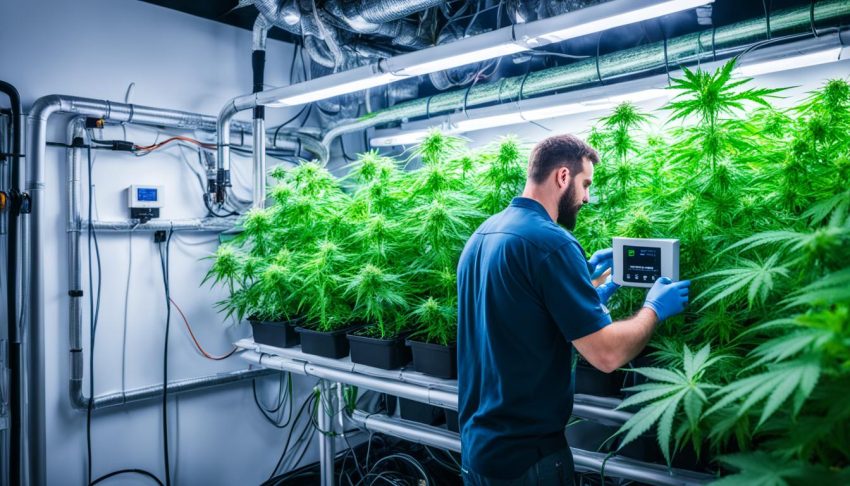
Key Takeaways
- Understand the importance of VPD in cannabis cultivation for optimal plant growth
- Learn how to monitor and measure VPD using the right tools and techniques
- Discover the ideal VPD range for cannabis plants and how to maintain it
- Explore the role of cannabis HVAC systems in controlling VPD
- Identify environmental factors that affect VPD and how to adjust them
Understanding Vapor Pressure Deficit (VPD)
VPD is key in cannabis growing. It’s the gap between air moisture and what it can hold when full. This balance affects cannabis plant health and growth.
What is VPD?
VPD shows how dry the air is. It’s the gap between actual and saturation vapor pressure. Think of it as air’s thirst – high VPD means air can take more moisture from plants.
Why is VPD Important for Cannabis Cultivation?
Keeping the right VPD range is vital for cannabis growth. VPD impacts plant processes like transpiration and nutrient uptake. Too low, and plants might get fungal diseases. Too high, and they could stress, wilt, and yield less.
Mastering VPD is key to growing great cannabis. By managing the factors that affect VPD, growers can help their plants flourish.
Ideal VPD Range for Cannabis Plants
Keeping the right vapor pressure deficit (VPD) is key for growing cannabis plants well. The best VPD range helps plants manage their water and nutrients well. This leads to better growth and more yield.
Experts say the best VPD for cannabis is between 0.8 and 1.2 kPa. This is the perfect spot for plants to take in water and nutrients. It also stops problems like wilting, nutrient shortages, or mold.
| Growth Stage | Optimal VPD Range (kPa) |
|---|---|
| Seedling | 0.6 – 1.0 |
| Vegetative | 0.8 – 1.2 |
| Flowering | 0.9 – 1.2 |
The best VPD range can change a bit based on the cannabis type and the environment. Growers should watch their plants closely. They should adjust as needed to keep the right VPD.
VPD that’s too low (under 0.6 kPa) can make plants waterlogged. This can cause root rot, mold, and problems with nutrient uptake. On the other hand, high VPD (over 1.2 kPa) can stress plants. This leads to wilting, nutrient shortages, and less yield.
Knowing and keeping the right VPD for your cannabis plants helps them grow well and stay healthy. This leads to a successful and rewarding grow.
Monitoring and Measuring VPD
It’s key to accurately monitor and measure vapor pressure deficit (VPD) for the best cannabis growth. By learning about VPD monitoring techniques and VPD measurement devices, you can track VPD data well. This helps you make smart choices to keep your plants in the perfect VPD range.
Tools for Measuring VPD
There are many tools to measure VPD in your grow space. Some top VPD measurement devices are:
- Hygrometers: These tools measure temperature and humidity, helping you figure out VPD.
- VPD meters: These give you the current VPD levels and let you see past data.
- Environmental monitoring systems: These systems track VPD and log data for your grow room.
When picking a VPD measurement device, think about its accuracy, how detailed it is, how it logs data, and how easy it is to use. This ensures you get trustworthy VPD data for your cannabis.
| VPD Measurement Device | Typical Accuracy | Key Features |
|---|---|---|
| Hygrometer | ±2-5% RH | Measures temperature and humidity; requires manual VPD calculation |
| VPD Meter | ±0.1 kPa | Provides direct VPD readout; may include data logging and trending |
| Environmental Monitoring System | ±1% RH, ±0.3°C | Integrated VPD monitoring and advanced data tracking capabilities |
Using the right VPD monitoring techniques and VPD measurement devices helps your cannabis plants grow well. This leads to better yields and quality of your product.
Cannabis HVAC Systems for VPD Control
Keeping the right vapor pressure deficit (VPD) is key for growing cannabis well. HVAC systems are crucial for managing VPD in grow rooms. They help create the best environment for cannabis plants to grow strong.
Cannabis HVAC systems for VPD control have important parts that work together. Dehumidifiers take out extra moisture, keeping humidity low and VPD in check. Air conditioners also cool the room, which is important for managing VPD.
Choosing the right HVAC equipment for VPD management is vital. You need to think about the grow room size, how many plants there are, and what conditions you want. Talking to HVAC experts who know about cannabis can help you pick the best system for your needs.
| HVAC Component | Purpose |
|---|---|
| Dehumidifier | Removes excess moisture from the air to maintain optimal humidity levels |
| Air Conditioner | Lowers the temperature to help regulate the VPD |
| Ventilation System | Circulates and replenishes the air to ensure proper air exchange |
Getting the right cannabis HVAC systems for VPD control is important for plant health and big yields. It’s key to keep an eye on and adjust these systems as needed to keep the VPD just right.
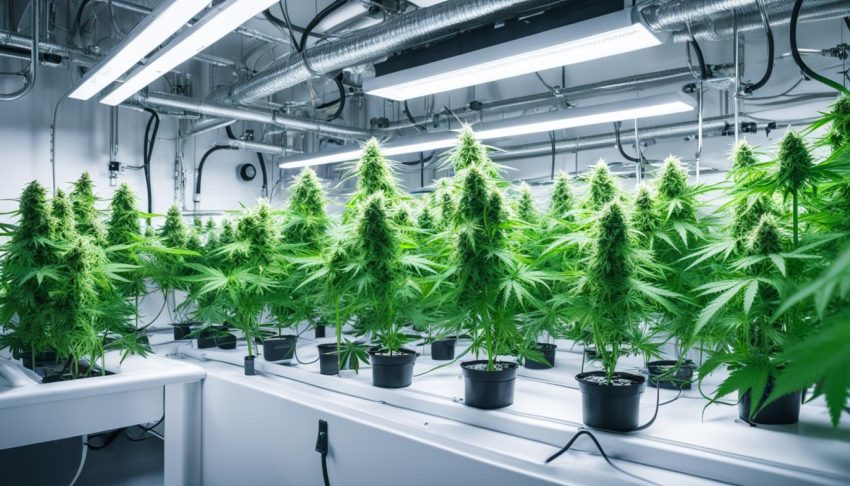
“Proper HVAC management is the foundation of a successful cannabis grow operation. It’s not just about temperature and humidity – it’s about creating the perfect VPD environment for your plants to thrive.”
Environmental Factors Affecting VPD
For cannabis growers, knowing how environmental factors affect vapor pressure deficit (VPD) is key. Temperature and humidity are two main factors that change VPD. By understanding how these factors work together, growers can keep the VPD in the best range for their plants.
Temperature
Temperature greatly affects VPD. When it gets hotter, air can hold more moisture, making VPD go up. But when it gets cooler, air holds less moisture, making VPD go down.
Keeping the temperature right is vital for managing VPD. Cannabis plants do best in a temperature of 70-85°F (21-29°C). If the temperature goes too far from this, it can hurt the plant’s growth or stress it out.
Humidity
Humidity, or the air’s water vapor, also changes VPD. More humidity means a lower VPD, and less humidity means a higher VPD.
The best humidity for cannabis is between 50-70%. If humidity is too low or too high, it can stop the plant from breathing and getting water and nutrients right.
By watching and adjusting temperature and humidity, growers can keep the right environmental factors influencing VPD. This helps their cannabis plants grow well throughout the whole process.
Adjusting Environmental Parameters
Keeping the right environment is key for managing the vapor pressure deficit (VPD) in your cannabis grow room. By adjusting temperature and humidity, you help your plants grow well and avoid stress and disease. Let’s look at two main ways to control VPD: dehumidification and air conditioning.
Dehumidification Techniques
Dehumidification helps control high humidity and keeps VPD in check. Here are some ways to do it:
- Use a commercial-grade dehumidifier made for grow rooms. These machines quickly take out extra moisture, keeping humidity low.
- Try passive dehumidification with desiccant bags or moisture-absorbing materials. They help stop humidity from building up without needing power.
- Make sure there’s good airflow and ventilation to keep air moving and stop humid pockets from forming.
Air Conditioning for VPD Management
Air conditioning is vital for keeping your cannabis plants at the right temperature. This helps manage VPD. Here are some air conditioning tips:
- Get an air conditioning unit that fits your grow room well. Units that are too big or too small can’t keep the temperature steady.
- Consider zoned air conditioning systems. They let you control the temperature in different parts of the room for even VPD levels.
- Link your air conditioning with your grow room’s control systems. This way, it can adjust the VPD automatically based on what’s happening in real time.
Using dehumidification and air conditioning together helps make a great environment for your cannabis plants. This leads to better growth, more yields, and higher quality products.
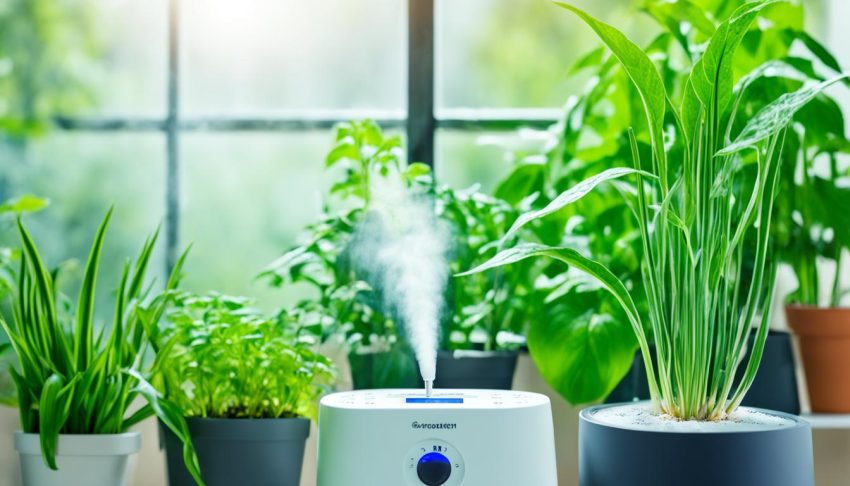
| Dehumidification Technique | Benefits |
|---|---|
| Commercial-grade dehumidifier | Quickly removes excess moisture from the air, maintaining optimal humidity levels |
| Passive dehumidification (desiccant bags, moisture-absorbing materials) | Cost-effective, low-energy solution to prevent humidity buildup |
| Proper airflow and ventilation | Promotes air circulation and prevents stagnant, humid pockets |
Incorporating VPD into Your Grow Room Management
Cultivating cannabis requires careful control over the environment. Using vapor pressure deficit (VPD) in your grow room is crucial for success. It helps create healthier plants, improves growing methods, and boosts the quality and yield of your cannabis.
VPD is a key factor in managing your grow room. It helps you adjust temperature, humidity, and airflow. This ensures your plants get what they need at every growth stage.
- Keep an eye on VPD levels to spot any changes or issues.
- Adjust things like HVAC systems, dehumidifiers, and fans to keep the best VPD for your plants.
- Link VPD with your nutrient plan, as it affects how plants take in water and nutrients.
- Use VPD to check on your grow room’s health and performance.
By adding VPD to your grow room management, you can make your growing better. This leads to healthier plants, more yield, and a more efficient grow operation.
| Environmental Factor | Ideal Range for Cannabis VPD |
|---|---|
| Temperature | 68-82°F (20-28°C) |
| Relative Humidity | 40-70% |
| Vapor Pressure Deficit | 0.8-1.2 kPa |
“Adding VPD to your grow room management is key for growing healthy, top-performing cannabis plants. It lets you adjust your environment for the best yield and quality.”
Common VPD Issues and Troubleshooting
Keeping the right vapor pressure deficit (VPD) is key for growing cannabis well. Growers often face VPD problems that can hurt plant health and yield. We’ll look at common VPD issues and how to fix them.
Low VPD
A low VPD can lead to issues like less transpiration, more disease risk, and slow growth. This usually happens when humidity is high and temperature is low. To fix this:
- Boost air circulation and ventilation for better air flow.
- Up the temperature in your grow room to an ideal range.
- Use dehumidifiers to lower humidity and adjust VPD levels.
High VPD
Too high a VPD can stress plants, cause wilting, and increase water loss. This is often due to low humidity and high temperature. Here’s what to do:
- Lower the temperature to a better range.
- Use humidifiers or misting systems to raise humidity.
- Keep soil moist and water plants more often to prevent dehydration.
VPD Fluctuations
Big or sudden VPD changes can harm your cannabis plants. They can cause stress, slow growth, and damage. To keep VPD stable:
- Watch your grow room’s temperature and humidity closely.
- Change environmental settings slowly and a little at a time.
- Use automated climate control systems for steady VPD all day and night.
Understanding and fixing VPD issues helps your cannabis plants grow better. A well-managed VPD is crucial for healthy plants and a good harvest.
Conclusion
This article has shown how Vapor Pressure Deficit (VPD) is key in cannabis growing. It’s vital to manage VPD in your HVAC system well. By knowing how VPD affects plant health and growth, growers can make their environment better.
We talked about the best VPD range for cannabis and how to measure it. We also looked at the important parts of cannabis HVAC systems. These systems help keep VPD levels right during the grow cycle.
Managing VPD is very important for growing cannabis. It affects the health, productivity, and quality of your plants. By using what we’ve shared here, growers can make sure their HVAC systems work well for VPD control. This leads to better yields, healthier plants, and a successful grow.
FAQ
What is vapor pressure deficit (VPD)?
VPD is the difference between the air’s moisture and its saturation point. It’s key in cannabis growth, affecting how plants transpire and control their temperature.
Why is VPD important for cannabis cultivation?
VPD impacts the plant’s ability to breathe, absorb nutrients, and grow. Keeping VPD in the right range is vital for healthy, productive plants.
What is the ideal VPD range for cannabis plants?
The best VPD for cannabis is between 0.8 and 1.2 kPa. This range helps plants breathe well and take in nutrients efficiently.
How can I monitor and measure VPD in my cannabis grow environment?
Use tools like hygrometers, psychrometers, and VPD sensors to track VPD. These help keep your grow space at the perfect moisture level.
How can cannabis HVAC systems help control VPD?
HVAC systems for cannabis control temperature and humidity. They use dehumidifiers and air conditioners to keep VPD just right for your plants.
What environmental factors affect VPD?
Temperature and humidity change VPD levels. It’s key to watch and adjust these to keep VPD in the best range.
How can I adjust environmental parameters to control VPD?
Adjust temperature and humidity with dehumidifiers and air conditioners. Watching and tweaking these can keep your VPD ideal for your cannabis.
How can I incorporate VPD into my overall grow room management strategy?
Adding VPD monitoring and control to your grow room helps with better decisions on environment, nutrients, and more. It makes for perfect growing conditions.
What are some common VPD issues and how can I troubleshoot them?
Issues like low or high VPD can happen. Fix them by tweaking temperature, humidity, or HVAC settings to get VPD back in check for your plants.

